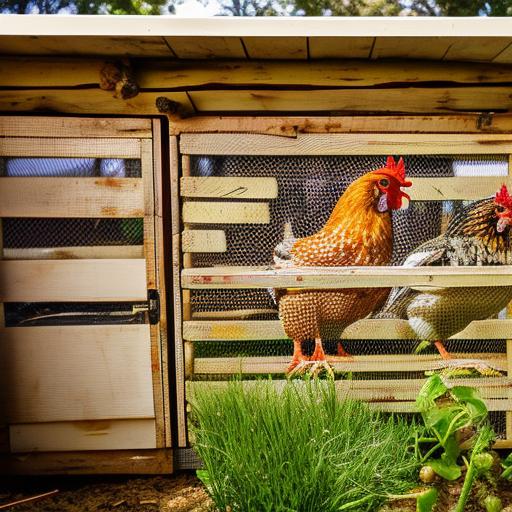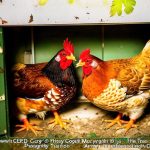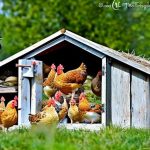Introduction: Hannah Montana’s Chicken Coop and Urban Farming
Urban farming has become increasingly popular in recent years as people seek sustainable alternatives to traditional agriculture. With limited space and resources in urban areas, finding innovative ways to grow food locally is essential for promoting food security and reducing the environmental impact of food production. One shining example of sustainable urban farming is Hannah Montana’s Chicken Coop, a model farm that has revolutionized the way people think about urban agriculture.
The Rise of Urban Farming and the Need for Sustainable Practices
Urban farming has seen a significant rise in popularity in recent years, as more people recognize the importance of sustainable practices and local food production. With the increasing urbanization of our world, it is becoming more challenging to rely solely on traditional agriculture to meet the growing demand for food. Urban farming offers a solution by bringing food production closer to where people live, reducing transportation costs and carbon emissions associated with long-distance food distribution.
However, with limited space and resources in urban areas, it is crucial to implement sustainable practices in urban farming. This includes using organic fertilizers, conserving water, and minimizing waste. Sustainable practices not only benefit the environment but also promote healthier and more nutritious food. By growing food locally, urban farmers can reduce the need for pesticides and preservatives, resulting in fresher and more flavorful produce.
The Benefits of Raising Chickens in an Urban Environment
Raising chickens in an urban environment offers numerous benefits. One of the most obvious advantages is the availability of fresh eggs. Chickens are prolific layers, and having a backyard flock can provide a steady supply of nutritious eggs for urban farmers. In addition to eggs, chickens also provide natural pest control. They eat insects and other pests that can damage crops, reducing the need for chemical pesticides.
Furthermore, raising chickens can be a rewarding experience for individuals and families alike. It teaches responsibility and provides an opportunity to connect with nature in an urban setting. Chickens are relatively low-maintenance animals, making them suitable for urban environments. They require minimal space and can thrive in small backyard coops.
Hannah Montana’s Chicken Coop: A Model for Sustainable Urban Farming
Hannah Montana’s Chicken Coop is a shining example of sustainable urban farming. Located in the heart of a bustling city, this model farm demonstrates how to maximize limited space and resources to create a thriving urban farm. The chicken coop itself is designed with sustainability in mind, incorporating features such as rainwater harvesting, solar panels for electricity, and composting systems.
The farm also practices organic farming methods, using natural fertilizers and avoiding chemical pesticides. By growing a variety of fruits, vegetables, and herbs, Hannah Montana’s Chicken Coop showcases the potential for diverse food production in an urban environment. The farm also serves as an educational center, offering workshops and tours to inspire others to start their own urban farms.
The Importance of Proper Chicken Coop Design and Maintenance
Proper chicken coop design and maintenance are crucial for the health and well-being of the chickens. A well-designed coop provides adequate space for the chickens to move around, roost, and lay eggs comfortably. It should also have proper ventilation to prevent the buildup of ammonia from chicken waste, which can be harmful to the birds’ respiratory system.
Regular maintenance is essential to ensure a clean and healthy environment for the chickens. This includes cleaning out the coop regularly, providing fresh bedding, and checking for signs of pests or disease. It is also important to provide access to fresh water and nutritious feed at all times.
When designing a chicken coop, it is important to consider factors such as predator protection, ease of cleaning, and accessibility for egg collection. Additionally, incorporating sustainable features such as rainwater harvesting or solar panels can further enhance the sustainability of the coop.
How Hannah Montana’s Chicken Coop is Revolutionizing Urban Agriculture
Hannah Montana’s Chicken Coop is revolutionizing urban agriculture by challenging the traditional notion of what is possible in an urban environment. By showcasing the potential for sustainable food production in a small space, the farm is inspiring others to think creatively and start their own urban farms.
The farm’s success has also attracted attention from local communities and policymakers, leading to increased support for urban agriculture initiatives. By demonstrating the economic viability and environmental benefits of urban farming, Hannah Montana’s Chicken Coop is changing the way people think about food production and consumption.
The Impact of Hannah Montana’s Chicken Coop on Local Communities
Hannah Montana’s Chicken Coop has had a positive impact on local communities. By providing access to fresh, healthy food, the farm has improved food security in the area. It has also brought people together, fostering a sense of community and connection to the land.
The farm has also inspired other individuals and organizations to start their own urban farms. This has led to a proliferation of small-scale urban agriculture projects, further enhancing food security and promoting sustainable practices in the community.
The Role of Technology in Urban Farming: Lessons from Hannah Montana’s Chicken Coop
Technology plays a crucial role in urban farming, enabling farmers to maximize limited space and resources. Automated watering systems, for example, can help conserve water by delivering precise amounts of water directly to the plants’ roots. Smart sensors can monitor soil moisture levels, temperature, and other environmental factors, allowing farmers to make data-driven decisions and optimize crop growth.
Hannah Montana’s Chicken Coop has embraced technology in its design. The farm utilizes automated systems for watering and feeding the chickens, reducing labor and ensuring consistent care. It also incorporates smart sensors to monitor environmental conditions and adjust lighting and temperature accordingly.
Overcoming Challenges in Urban Farming: Lessons from Hannah Montana’s Chicken Coop
Urban farming comes with its fair share of challenges. Limited space, zoning regulations, and access to resources are just a few of the obstacles that urban farmers face. However, Hannah Montana’s Chicken Coop has overcome these challenges through innovative design and community engagement.
By maximizing vertical space and utilizing rooftop gardens, the farm has been able to grow a significant amount of food in a small area. The farm has also worked closely with local authorities to navigate zoning regulations and secure necessary permits. Additionally, the farm has formed partnerships with local businesses and organizations to access resources and build a supportive network.
The Future of Urban Farming and the Role of Hannah Montana’s Chicken Coop
The future of urban farming holds great potential for addressing food insecurity and promoting sustainability. As cities continue to grow, finding ways to produce food locally will become increasingly important. Urban farms like Hannah Montana’s Chicken Coop can serve as models for future projects, demonstrating the possibilities for sustainable food production in urban environments.
By incorporating sustainable practices, utilizing technology, and engaging with local communities, urban farms can play a significant role in creating a more resilient and sustainable food system. As individuals, we can also contribute by starting our own urban farms or supporting local urban agriculture initiatives.
Conclusion: The Importance of Sustainable Urban Farming and Hannah Montana’s Chicken Coop as a Model for Change
Sustainable urban farming is essential for promoting food security, reducing environmental impact, and fostering community resilience. Hannah Montana’s Chicken Coop serves as a model for sustainable urban farming, showcasing the potential for small-scale food production in an urban environment.
By incorporating sustainable practices, utilizing technology, and engaging with local communities, Hannah Montana’s Chicken Coop has revolutionized the way people think about urban agriculture. It has inspired others to start their own urban farms and has had a positive impact on local communities.
As we look towards the future, it is crucial to prioritize sustainable practices in our food production systems. Whether it is through starting our own urban farms or supporting local initiatives, we can all contribute to creating a more sustainable and resilient food system. By following the example set by Hannah Montana’s Chicken Coop, we can make a positive impact on our communities and the environment.
Meet Walter, the feathered-friend fanatic of Florida! Nestled in the sunshine state, Walter struts through life with his feathered companions, clucking his way to happiness. With a coop that’s fancier than a five-star hotel, he’s the Don Juan of the chicken world. When he’s not teaching his hens to do the cha-cha, you’ll find him in a heated debate with his prized rooster, Sir Clucks-a-Lot. Walter’s poultry passion is no yolk; he’s the sunny-side-up guy you never knew you needed in your flock of friends!







